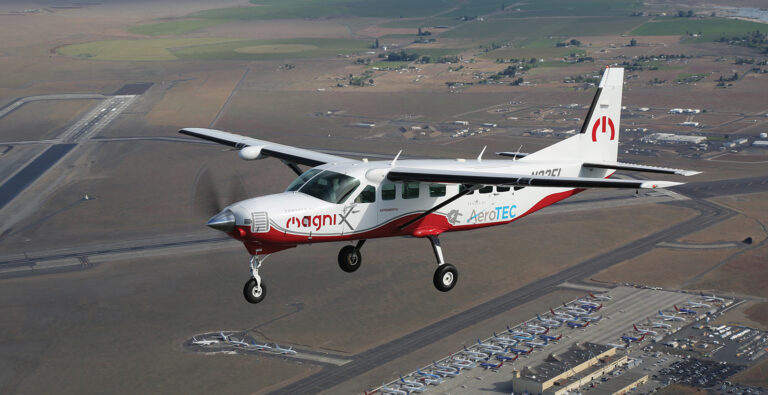Stay Up to Date
Submit your email address to receive the latest industry and Aerospace America news.
The Terrestrial Energy Systems Technical Committee works to advance the application of engineering sciences and systems engineering to the production, storage, distribution and conservation of energy for terrestrial uses.
AeroTEC and MagniX of Washington state flew a modified Cessna Grand Caravan 208B for 30 minutes in May on the all-electric aircraft’s first flight. The companies say the eCaravan, which can carry nine passengers, is the largest all-electric commerical aircraft. The plane was powered by a 750-horsepower (560 kilowatt) magni500 propulsion system from MagniX.
“As the world’s largest all-electric commercial aircraft, this is a significant milestone in disrupting the transportation industry,” said MagniX CEO Roei Ganzarski.
In further flight tests in 2020, the eCaravan climbed and cruised at 8,000 feet. The flight range remains one of the elusive milestones for electric planes since the battery energy density is much lower than liquid fuel energy density. To combat this barrier, new aircraft must be designed around the concept of battery-powered propulsion. Israeli firm Eviation designed one of these new planes. Eviation Alice is powered by the MagniX electric motor and is capable of carrying nine passengers.
“This path is slower and more expensive but eliminates any range limitations or anxiety,” Ganzarski said.
There are in fact, by some estimates, 200 aircraft designs that rely on electric power; some are purely electric, such as eCaravan, and some are hybrid. In addition to low energy density of the commonly used lithium-ion batteries, there are other obstacles for electric planes to penetrate a competitive market next to their liquid fuel-powered counterparts. The weight of the battery remains the same throughout the flight, whereas fuel weight diminishes after being consumed for combustion. Nonetheless, the promise of lowering emissions will be a major impetus for pursuing electric aircraft as the future of aviation.
Another promising technology for lowering emissions is biofuels for powering gas turbine engines. In May, Japan-based IHI Corp. obtained a new international standard (ASTM D7566 Annex 7 HC-HEFA SPK) for a biojet fuel production process based on microalgae found naturally in fresh water. IHI has carried out research and development on technologies to achieve mass outdoor/open-pond cultivation.
Also in biojet fuel production, in June, Japan-based Mitsubishi Power and partners Toyo Engineering Corp., JERA and JAXA, the Japan Aerospace Exploration Agency, started test operations for its fuel production from woody biomass through gasification and Fischer-Tropsch synthesis for aviation. The team continued verification operation of the test plant by analyzing the production fuel compatibility to ASTM standard (D7566 Annex 1).
In August and October, neat biojet fuels produced in the above-mentioned two projects were individually confirmed to meet their respective ASTM standards. The two research and development ventures focusing on the production of bio-derived aviation fuels using woody biomass and microalgae were started in Japan in 2017 as the commissioned project by the New Energy and Industrial Technology Development Organization. Japan’s Ministry of Economy, Trade and Industry and the Ministry of Land, Infrastructure, Transport and Tourism in 2015 had originally discussed and formed the concept and plans of the processes needed to realize flights using biojet fuel to commemorate the Tokyo 2020 Olympic and Paralympic Games. The games were postponed due to the covid-19 pandemic.
Biojet fuel is recognized as a new form of energy that will contribute to reducing CO2 emissions and configuring some of the key elements of sustainable aviation fuel. Through these projects, the project team has accumulated technology and skills for broader commercialization of biojet fuel.
Related Posts
Stay Up to Date
Submit your email address to receive the latest industry and Aerospace America news.




